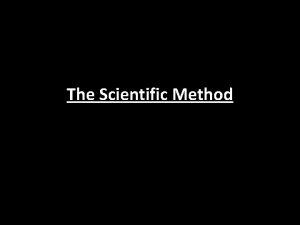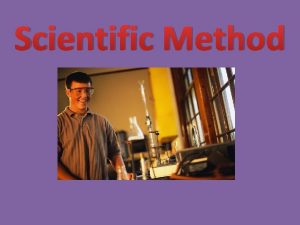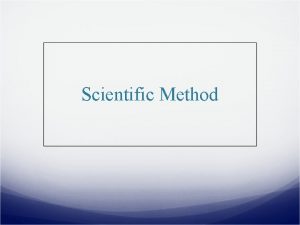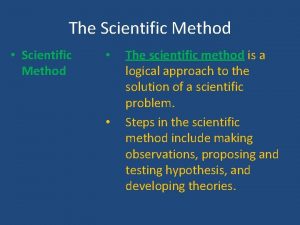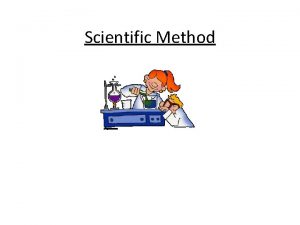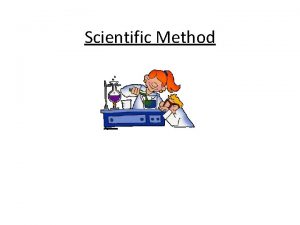The Scientific Method The scientific method Is how












- Slides: 12

The Scientific Method

The scientific method • Is how scientists as questions about the world and test the answers • In other fields: art, philosophy, music, history, specialists ask questions about the world • The scientific method is different

The scientific method defined: • The scientific method – Is a system of asking questions and then – Developing explanations and then – Testing these explanations against the reality of the natural world

Steps in the scientific method (1) • State a specific problem or question based on an observation of the natural world – A fact is a repeatable observation • With the problem in mind propose an explanation for what you observe. This explanation is the hypothesis

Steps in the scientific method (2) • Test the hypothesis – One way is to make more observations and see if they are ALL consistent with your hypothesis – Another way is set up a controlled test of the hypothesis. This is called the experiment • Controlled test means you have a control group of test subjects and an experimental group of test subjects

Steps in the scientific method (3) • Analyze the results of the experiment – Sometimes the results are clear cut and obvious; your hypothesis stands up (=correct) or it does not (=incorrect) – Sometimes the results suggest a new hypothesis; you start the process over again until your hypothesis is correct

The experiment • Control group: the benchmark – You treat the subjects or articles in the control group exactly the same as those in the experimental group but without the treatment you are testing • Experimental group – You vary one condition (the variable) and keep all other conditions the same as in the control group

The experiment • You collect data in an experiment • You summarize the data mathematically – Mean, mode, medium, range • You compare the data summary of the experimental group with the control group – Statistical tools are used – Compare means, standard deviations, variances

Three experiments to consider • Tomato experiment – Text page 14, see figure 1. 10 • Yellow fever experiment – Text page 17 -19 • Pasteur’s experiment

Louis Pasteur’s experiment • • • Hypothesis: “omnis cellula e cellua” Famous goose neck flask experiment Control flasks Experimental flasks Results confirm hypothesis (now theory) of biogenesis • Disproved hypothesis of spontaneous generation

Spontaneous Generation (1) • Up until the 17 th century biologists thought that simple living things appeared spontaneously • Francisco Redi did the famous decaying meat experiment – Control: decaying meat covered with a cloth – Experimental: decaying meat open to the air – No maggots in the control

Spontaneous Generation (2) • Spontaneous generation idea was revived with the invention of the microscope • Microorganisms and small animals seemed to appear spontaneously in water or broth • Pasteur’s experiment disproved spontaneous generation for the second time
 Scientific inquiry vs scientific method
Scientific inquiry vs scientific method How is a scientific law different from a scientific theory?
How is a scientific law different from a scientific theory? Hình ảnh bộ gõ cơ thể búng tay
Hình ảnh bộ gõ cơ thể búng tay Slidetodoc
Slidetodoc Bổ thể
Bổ thể Tỉ lệ cơ thể trẻ em
Tỉ lệ cơ thể trẻ em Gấu đi như thế nào
Gấu đi như thế nào Chụp tư thế worms-breton
Chụp tư thế worms-breton Alleluia hat len nguoi oi
Alleluia hat len nguoi oi Môn thể thao bắt đầu bằng từ chạy
Môn thể thao bắt đầu bằng từ chạy Thế nào là hệ số cao nhất
Thế nào là hệ số cao nhất Các châu lục và đại dương trên thế giới
Các châu lục và đại dương trên thế giới Cong thức tính động năng
Cong thức tính động năng
















